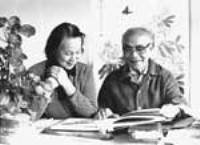 The 90-year-old lady loves to paint flowers but has never been a great fan of roses and peony as she believes that they have been over painted.
The 90-year-old lady loves to paint flowers but has never been a great fan of roses and peony as she believes that they have been over painted.
“They are too complicated. And a lot of people have painted them already,” Xiao Shufang said with a witty smile.
A retired professor of painting from the Central Academy of Fine Arts in Beijing and one of the most revered women artists in China today, Xiao is well known for her impressive portraits of simple and delightful flowers such as irises, azaleas, and lilacs. At times beautiful wild flowers that grow on mountains can be seen in her pictures.
“I like these delicate and humble flowers. Terse in shape and striking in color, they are impressive and easy to paint. Above all, they are close to my disposition,” said the gray-haired lady, sitting gracefully at her home in western Beijing. Her only daughter Xiao Hui, 61, and son-in-low Shang Yusheng, both retired science workers, live with her.
This talented professor spends most of her time in an ordinary, ground-floor apartment where she has lived with her family since 1972. Visitors to her home will recognize a huge photograph of her late husband, artist Wu Zuoren (1908-97).
Simple Life
Xiao said she always prefers life to be as simple as possible and loves to see things in their most natural environment.
This philosophy has been evident in her work she began at the art school of National Beiping University (now Peking University) in 1926.
Visitors to Xiao’s recent retrospective exhibition at the China National Art Museum, which ended on Wednesday, would have seen for themselves the amazing simplicity and beauty characterized in her art work, especially the ink paintings of flowers since the 1970s. They have made her a highly reputable artist.
The exhibition included more than 250 of Xiao’s works and showed about 40 photographs featuring her 90-year life.
This was the largest solo exhibition Xiao has ever had. As well as her ink paintings, oil paintings and watercolors were shown for the first time, covering figures, landscapes and flowers.
The exhibition gave an inspiring opportunity to review her 75-year artistic career and gives fans the opportunity to admire her diligent endeavors on the road of art, according to veteran artist Ai Zhongxin, Xiao’s colleague at the central academy.
“I started to learn art largely because of my uncle Xiao Youmei,” recalled the Tianjin-born painter, whose family are from Zhongshan of south China’s Guangdong Province.
A founder of modern Chinese music and a professor of music at the Beiping University, the gentleman discovered his niece’s talent for painting and recommended her to Lin Fengmian, then dean of the art school.
The perceptive discovery changed her whole life.
Following three years of study at the school, Xiao grasped the basic skills of Western painting and was able to hold an oil painting show together with two of her classmates upon graduation, in 1929.
From 1929 to 1930, Xiao had an opportunity to study oil painting and drawing as a student of master artist Xu Beihong (1895-1953), then director of the art department of the Central University in Nanjing and later first president of the central academy in Beijing.
It was also in the Nanjing school that she first met her future husband Wu Zuoren, who was also at the department.
“Although we were classmates, we did not talk much then. He only studied for six months and soon left to study in Europe. For six years when he was studying abroad, we lost track of each other,” Xiao said.
In the early 1930s, Xiao returned to Beijing and studied traditional Chinese ink painting under accomplished artists such as Qi Baishi. Early influence of the poetic and expressive styles of Chinese literati painting are seen extensively in Xiao’s later ink paintings.
From 1937 to 1940, Xiao studied woodcut, sculpture and oil painting in Switzerland, England and France and exhibited her ink paintings whilst there. The study expanded her vision of Western modern art.
After she returned from Europe, she worked as an art teacher in Shanghai and met Wu again. Both in their late 30s and having suffered unsuccessful marriages, the two lonely hearts soon fell in love and got married. The couple stayed together for 50 years until Wu passed away in 1997.
Reformative Spirit
In 1947, on the eve of the liberation of Beiping (now Beijing), the couple returned to the city to teach at the National Beiping Art School, later the Central Academy of Fine Arts, at the invitation of their mentor Xu Beihong.
For the rest of their careers, the couple both taught as professors in the art school. Following Xu, Wu later served as president of the central academy and chairman of the Chinese Artists Association.
Since teaching at the Chinese painting department of the central academy, Xiao has boldly experimented with the blending of watercolor and ink when portraying flowers, according to Professor Ai Zhongxin.
“After strenuous work, she finally found that she could express herself in both art forms, using the artistic language of traditional Chinese ink painting whilst creating a unique style of her own,” Ai said.
In late 1970s, Xiao began to change her painting.
“I don’t like to repeat the tradition or other artists. So I started to paint flowers in their natural environment, breaking away from the conventional patterns like flowers in a vase,” Xiao recalled, her eyes exuberant with delight.
Then she turned to bolder innovations in colors and composition.
In Xiao’s view, the colors of traditional ink painting are very limited, as the tradition of Chinese literati painting stresses the calligraphic effect of brushwork and the poetic mood of images, rather than the “superficial” element of colors.
As a result, traditional Chinese ink painting has lost a considerable part of its beauty, according to Xiao.
“So I began to apply the bright colors of watercolor into modern Chinese ink painting. Intentionally, I chose to paint flowers with peculiar colors, such as pure blue or pure red,” she noted.
She also absorbed the traditional compositional method of Chinese ink painting to leave large areas of empty space in her pictures and the perspective techniques of Western painting to make the images more realistic and lively.
“Auntie Xiao is never afraid of trying new things and is always working on a new idea,” said Song Gaoping, 62, an architect and painter who is a close friend of Xiao’s family.
Song’s words are certainly true.
In the 1920s, when few people in China had seen bicycles, she learned how to ride it in a single afternoon and dared to give her sister a lift the next day.
In 1932, when the sport of ice-skating was just becoming popular in Beijing, she astonished her family by winning the championship of north China.
At 90, Xiao Shufang is healthy and happy. She still paints.
It seems that the talented old lady will never be ready to stop expressing herself with her paintbrushes.
(The photo shows that Xiao Shufang (left) discusses art with her husband Wu Zuoren (1908-97) at their home in Beijing in the 1980s.)
(China Daily 08/27/2001)
